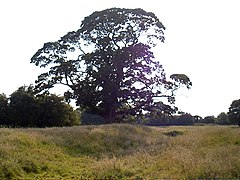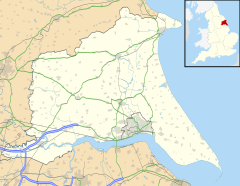Meaux, East Riding of Yorkshire
| Meaux | |
|---|---|
 Site of Meaux Abbey |
|
| Meaux shown within the East Riding of Yorkshire | |
| OS grid reference | TA097395 |
| • London | 160 mi (260 km) S |
| Civil parish | |
| Unitary authority | |
| Ceremonial county | |
| Region | |
| Country | England |
| Sovereign state | United Kingdom |
| Post town | BEVERLEY |
| Postcode district | HU17 |
| Dialling code | 01482 |
| Police | Humberside |
| Fire | Humberside |
| Ambulance | Yorkshire |
| EU Parliament | Yorkshire and the Humber |
| UK Parliament | |
Meaux (pronounced /mjus/ "mewss") is a hamlet in the East Riding of Yorkshire, England. It is about 6 1⁄2 miles (10 km) north of Hull city centre and 3 1⁄2 miles (6 km) east of Beverley.
Meaux is part of the civil parish of Wawne.
Meaux Abbey was a Cistercian Abbey near Meaux.
According to A Dictionary of British Place Names the name 'Meaux' is derived from Old Norse Mel-sǽr, meaning "Sandbank-pool".
Baines' History, Directory and Gazetteer of the County of York states that William the Conqueror gave the Meaux lordship to Gamel, who was born in Normandy at Meaux, a name he gave to the Holderness settlement which he populated with his own people. However, the Domesday Book records that in 1066 Ulf Fenman held the lordship, this transferring in 1086 to Drogo of la BeuvriËre, who was also Tenant-in-chief to William I. Meaux is recorded in the Domesday Book as "Melse". At the time of the survey the settlement was in the Middle Hundred of Holderness in the East Riding of Yorkshire. Meaux contained 29 villagers, 5 smallholders, 6 freemen, and 4 men-at-arms. There were 53 ploughlands, woodland, and 274 acres (111 hectares) of meadow.
...
Wikipedia

